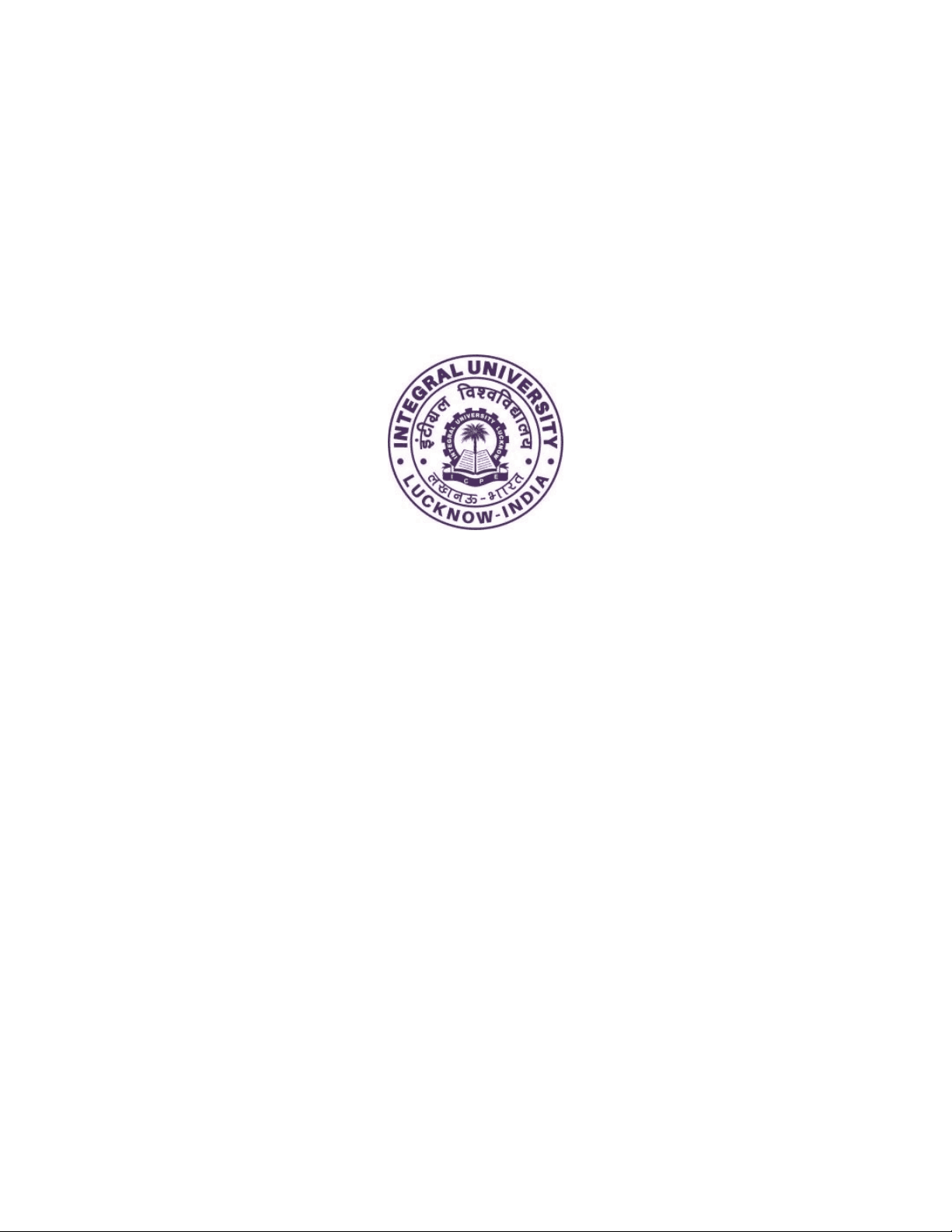
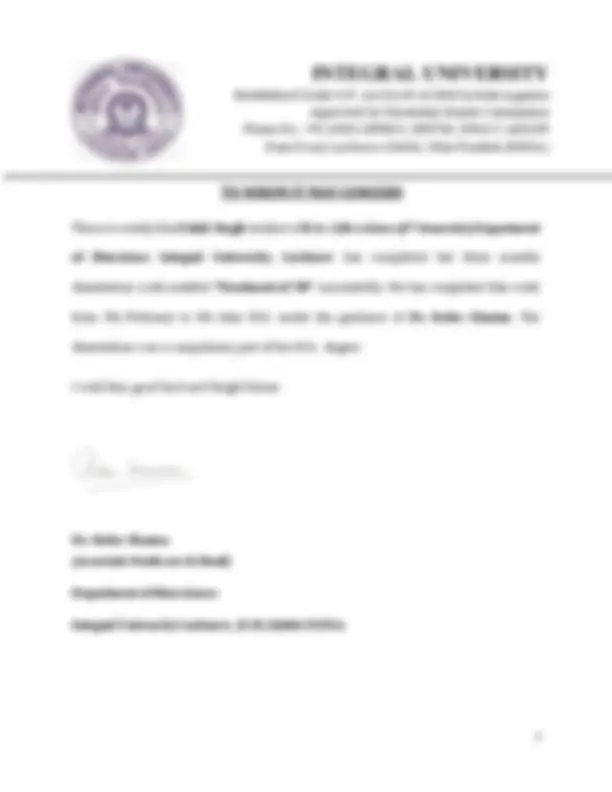
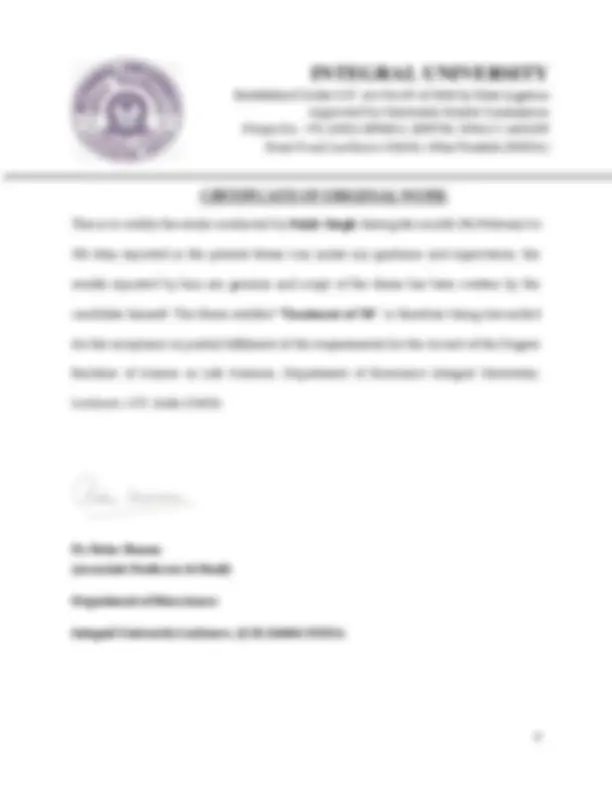
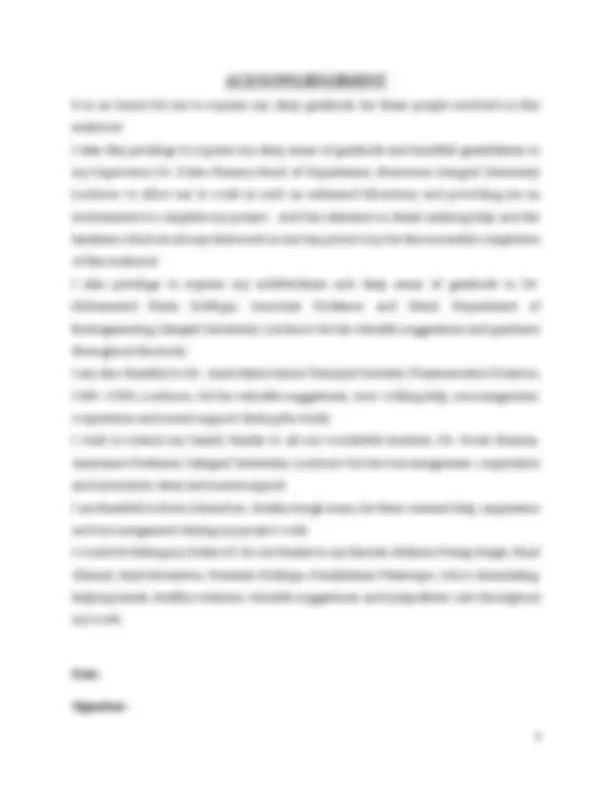
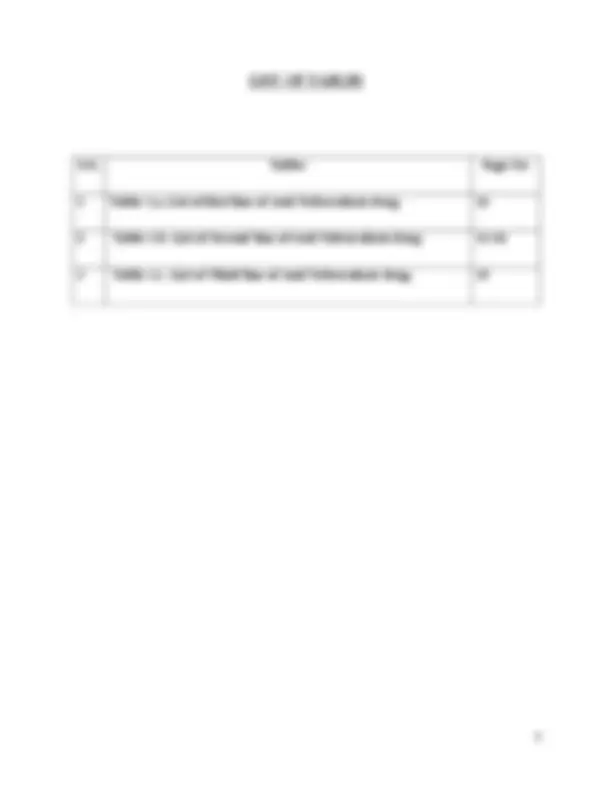
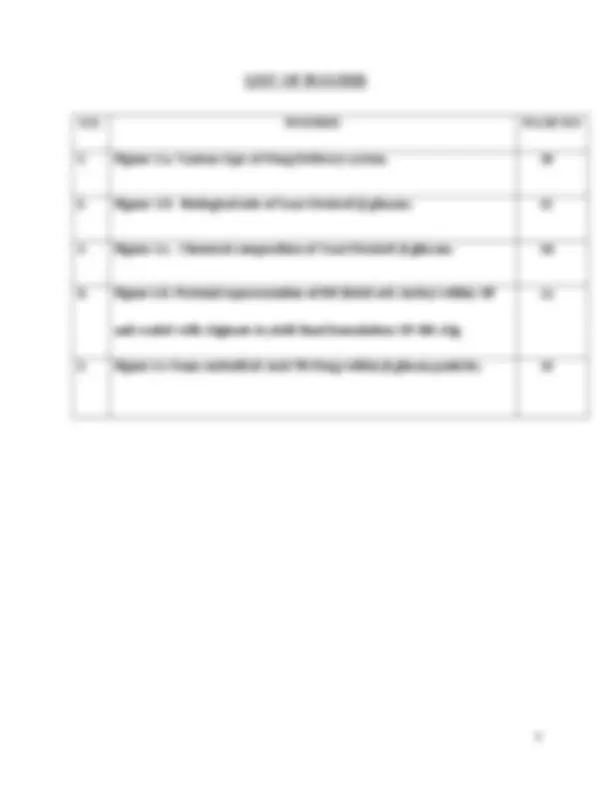
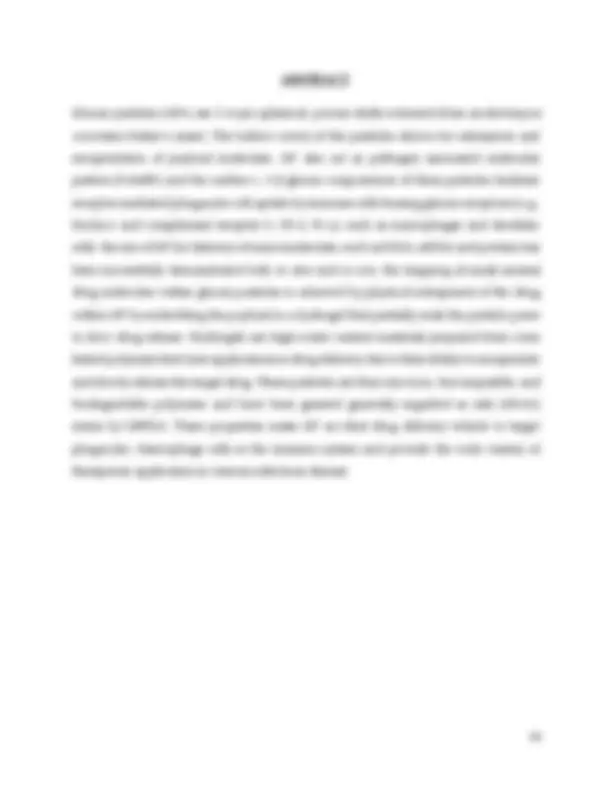
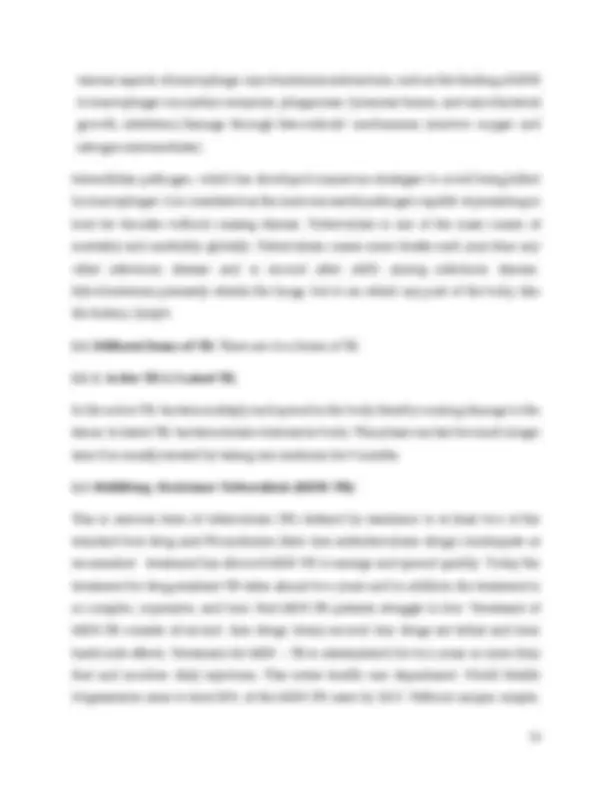
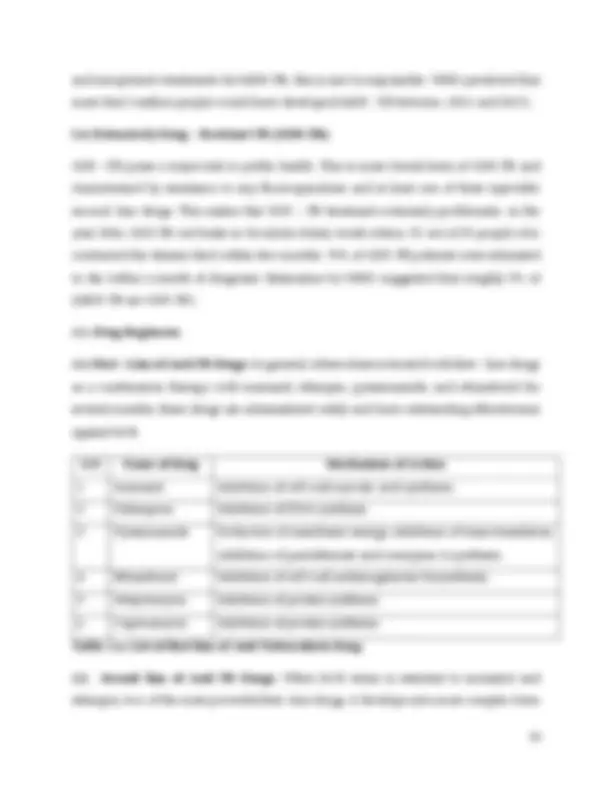
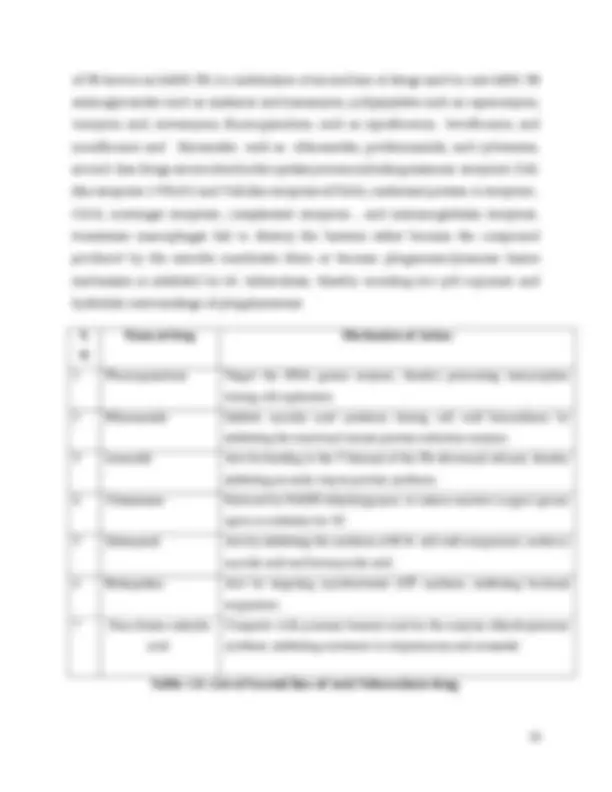
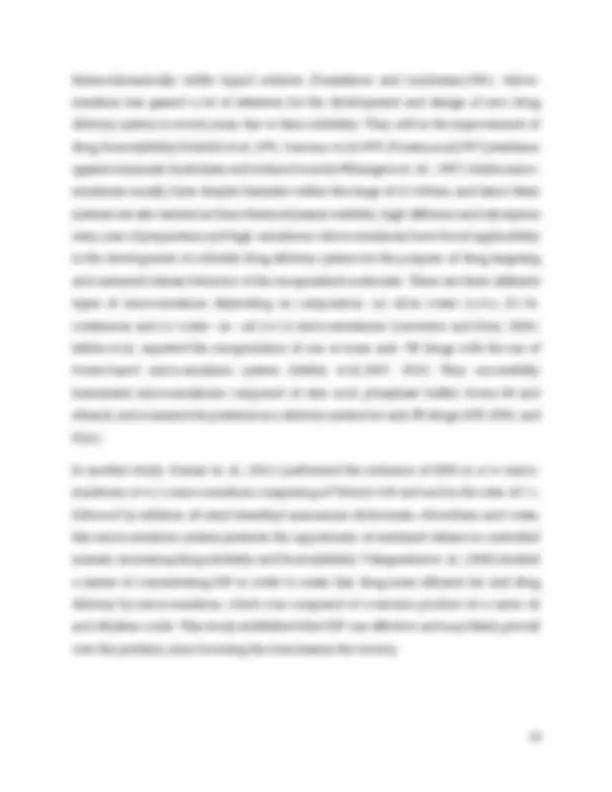
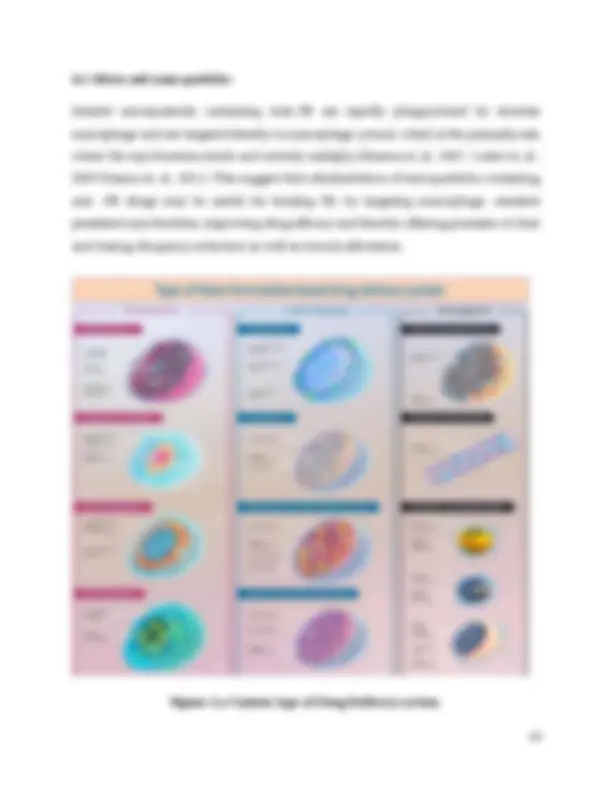
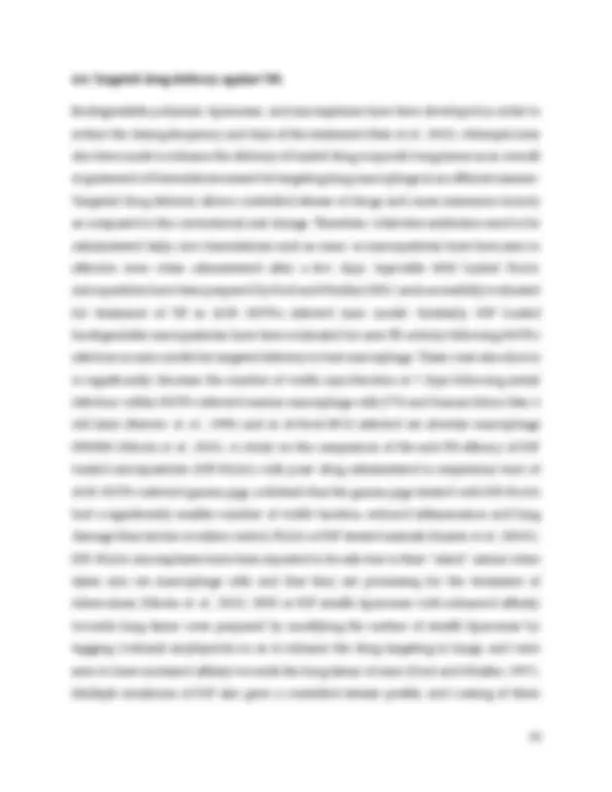
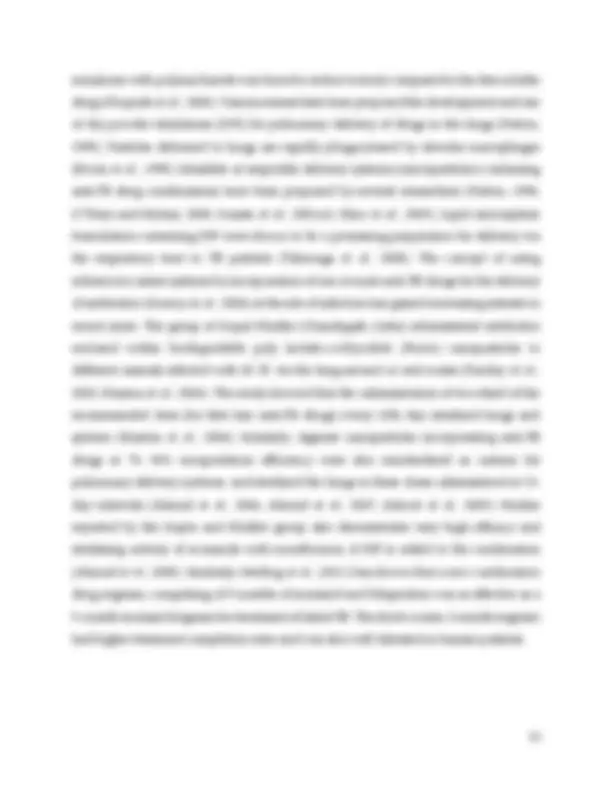
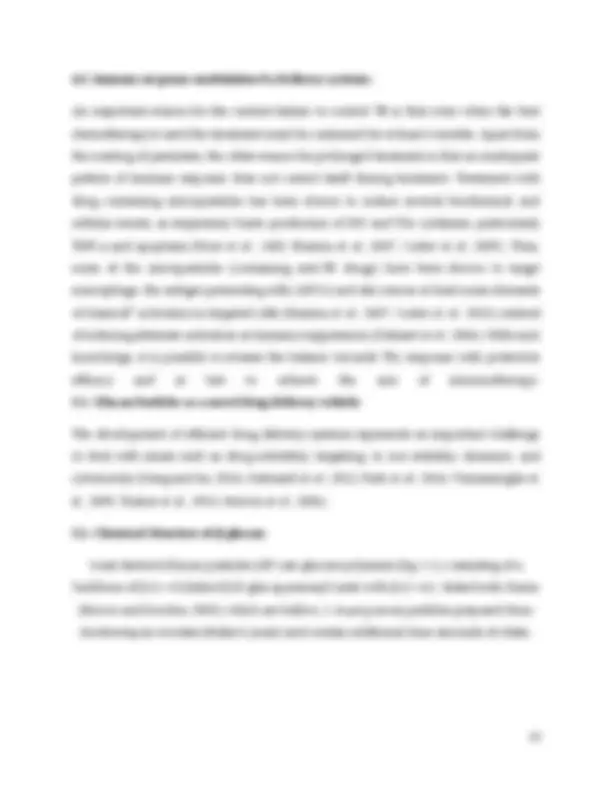
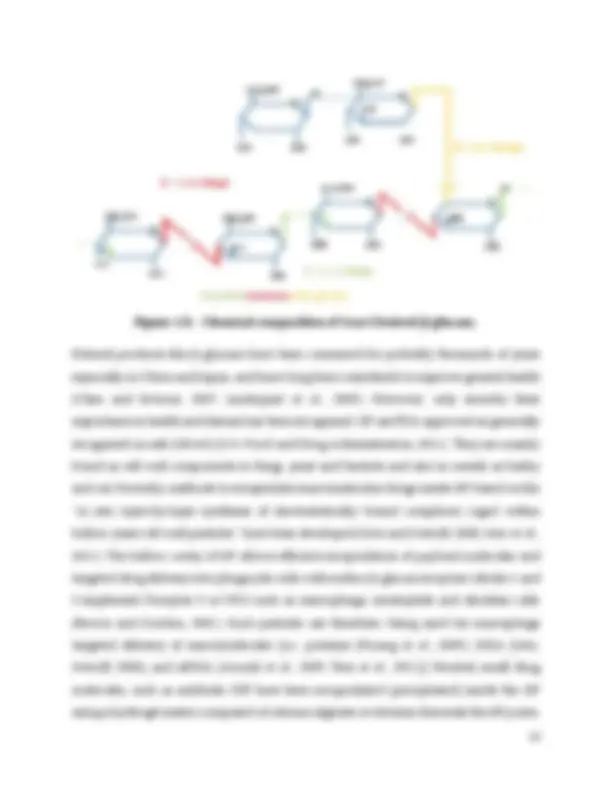
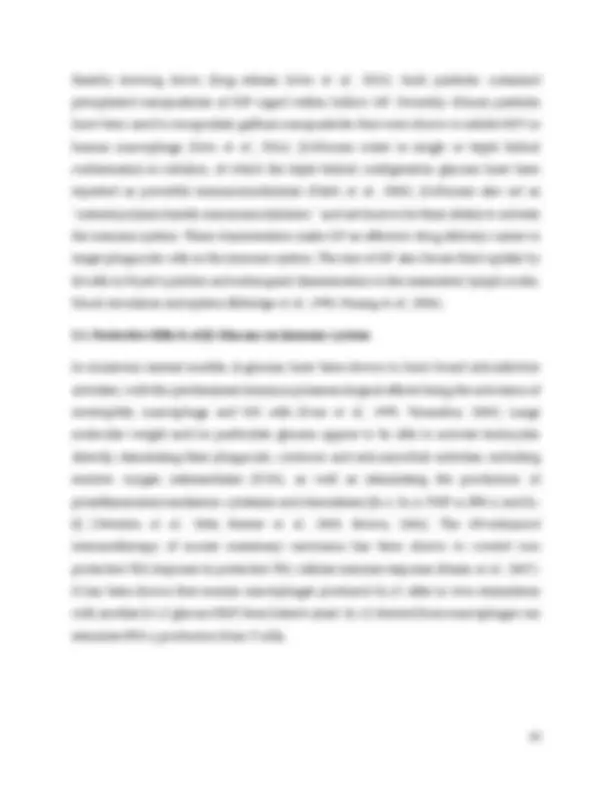
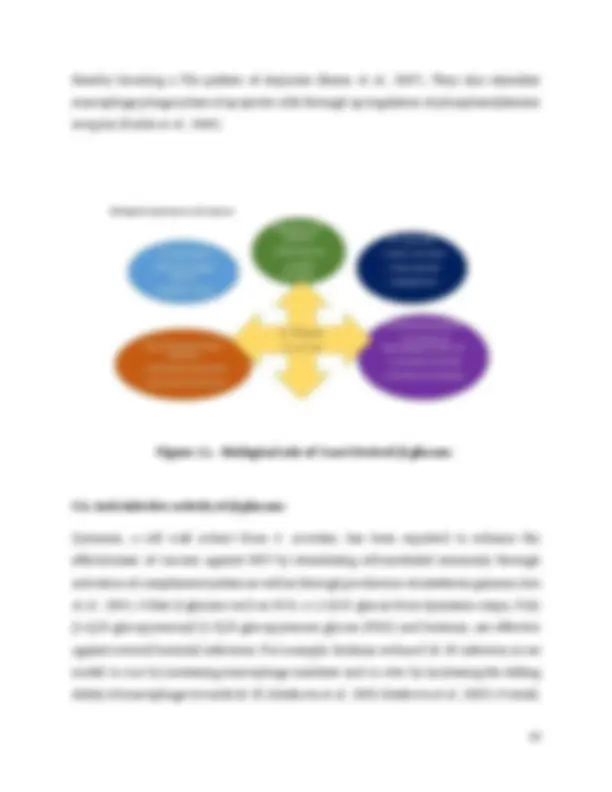
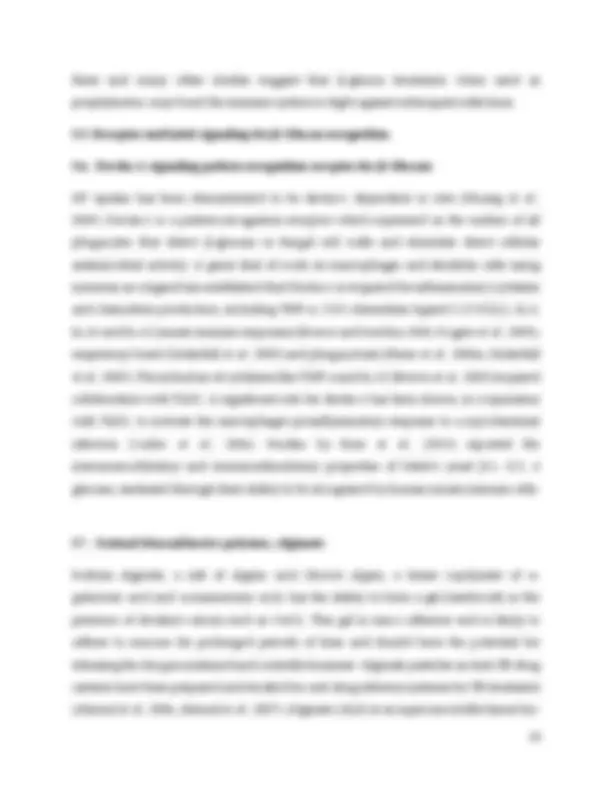
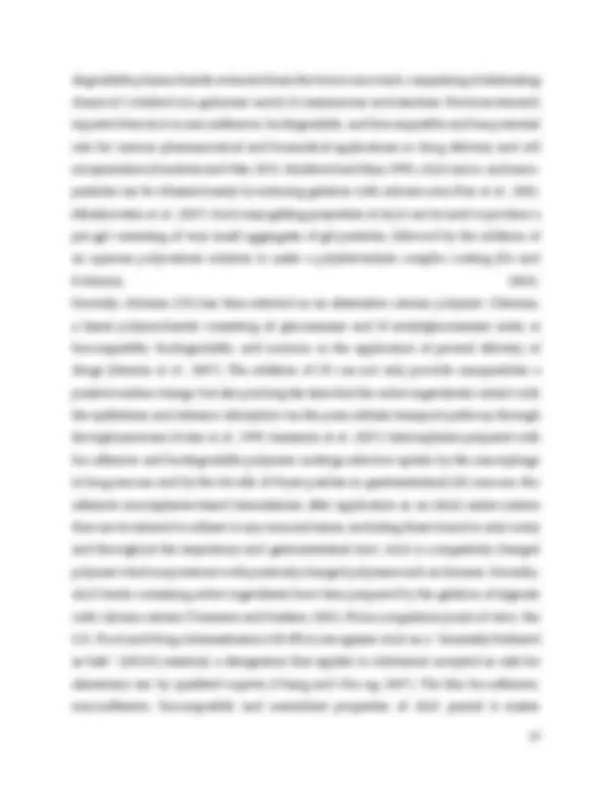
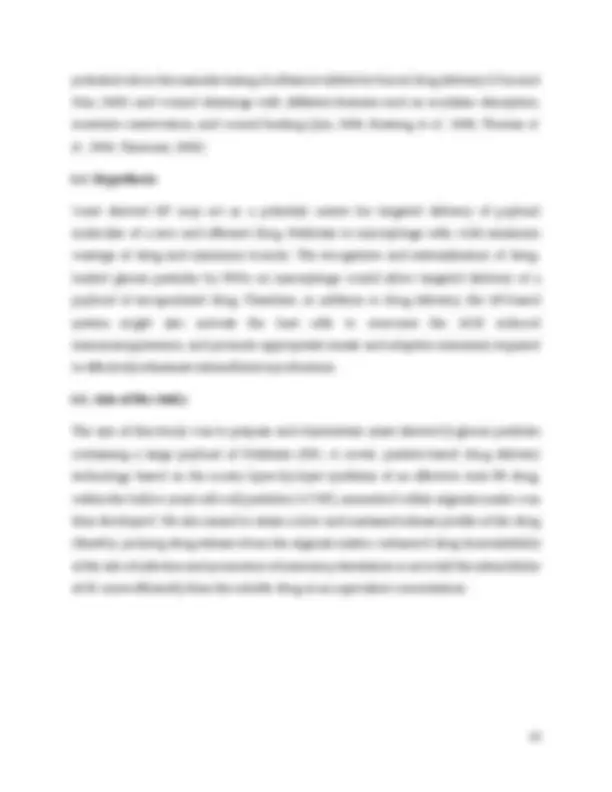
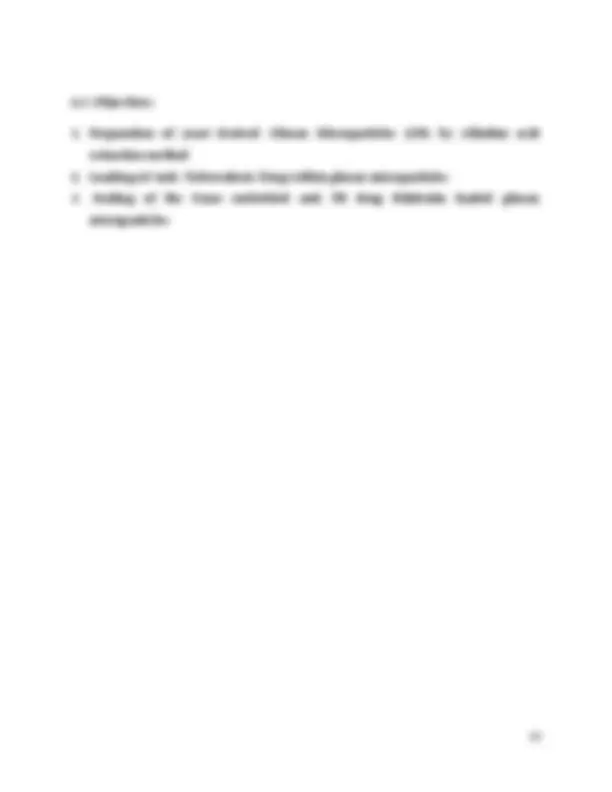
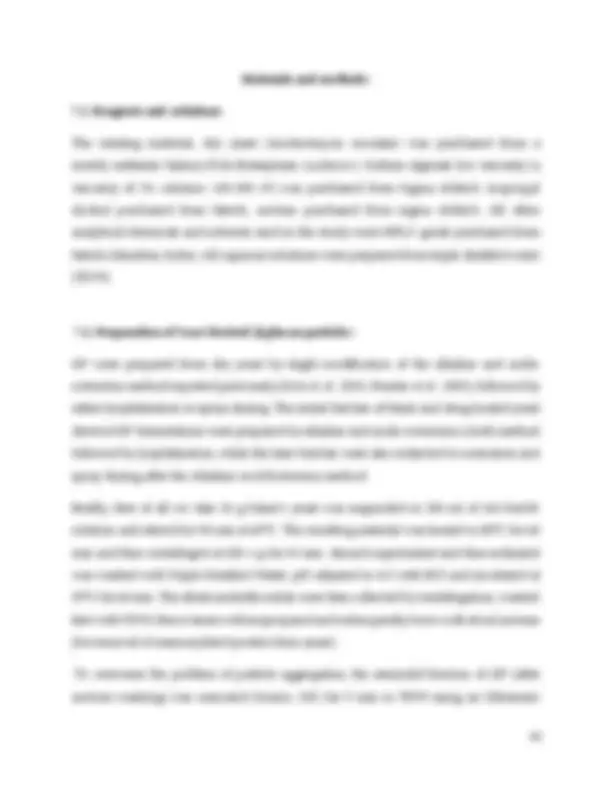
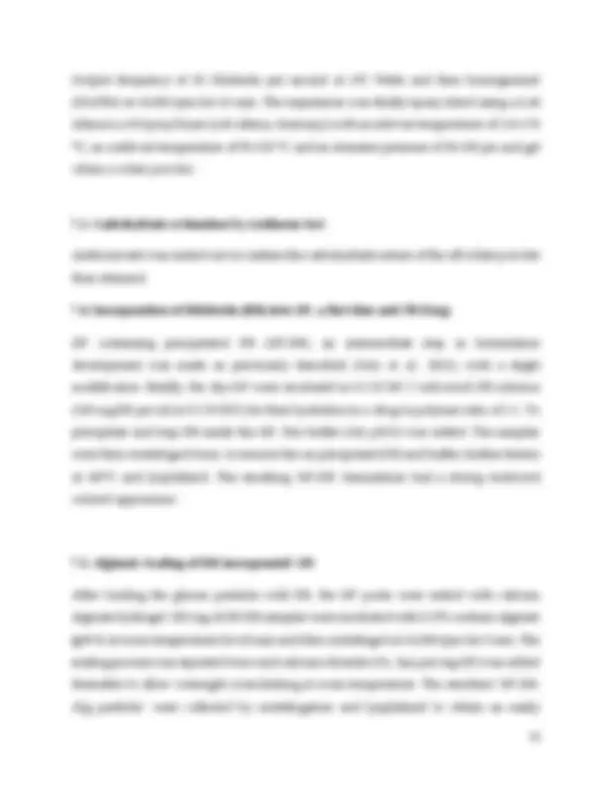
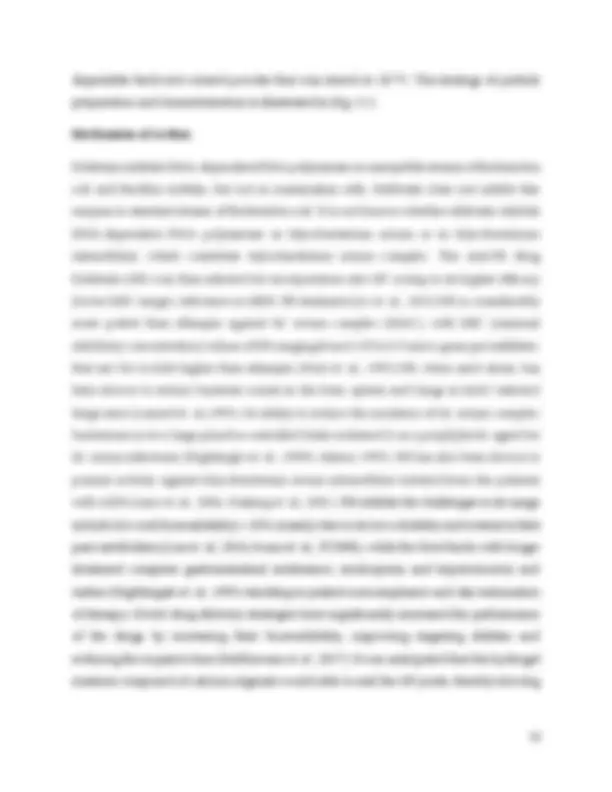
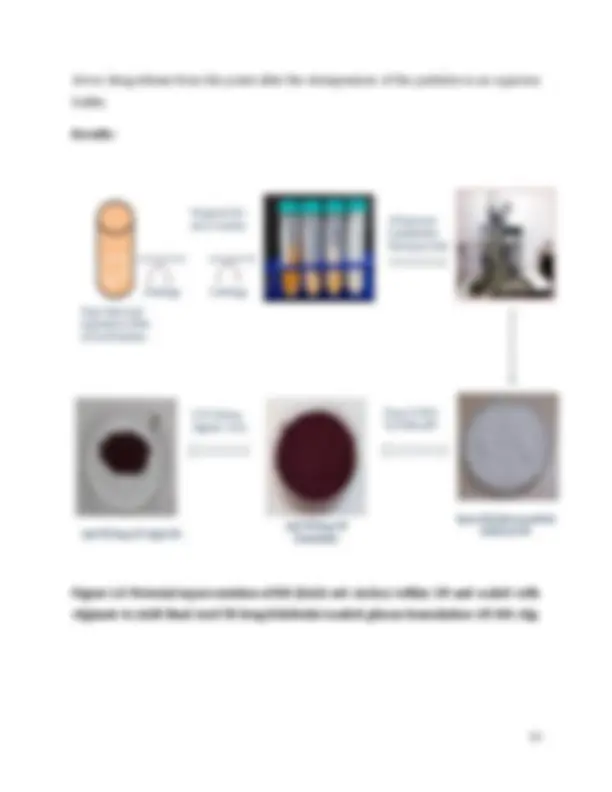
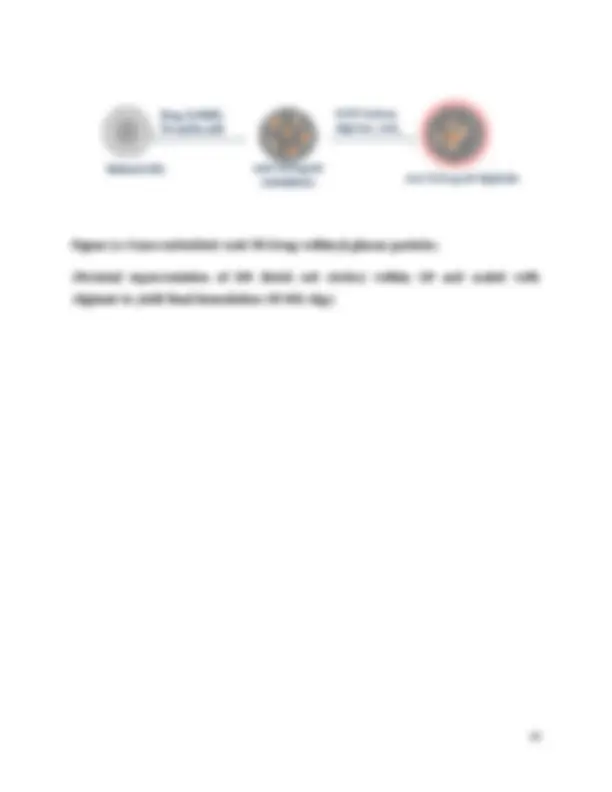
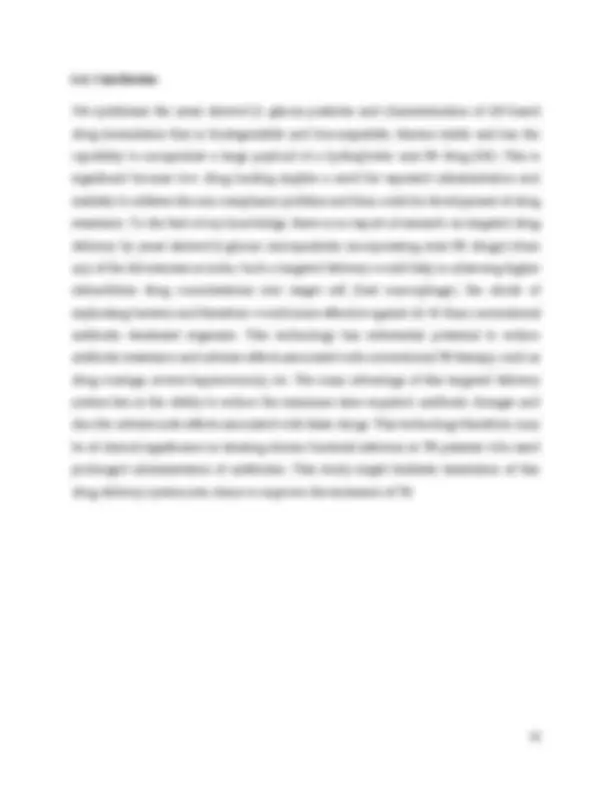
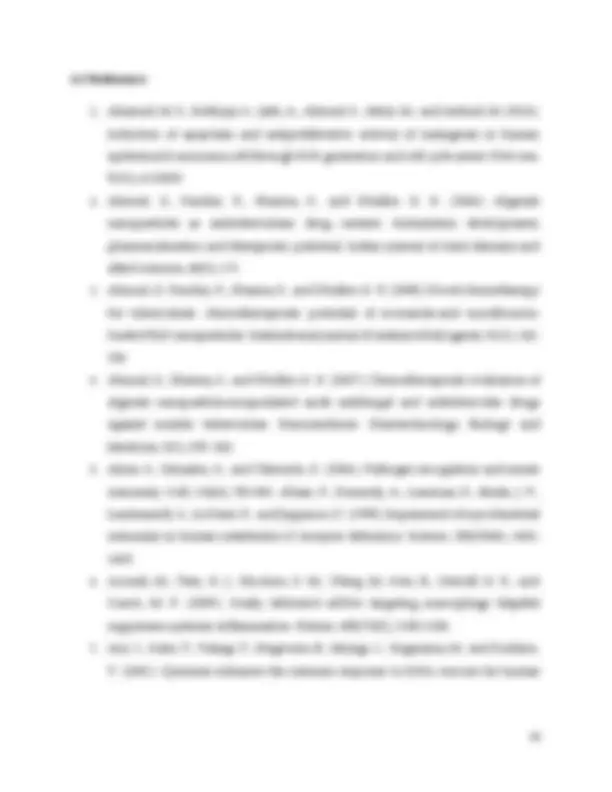
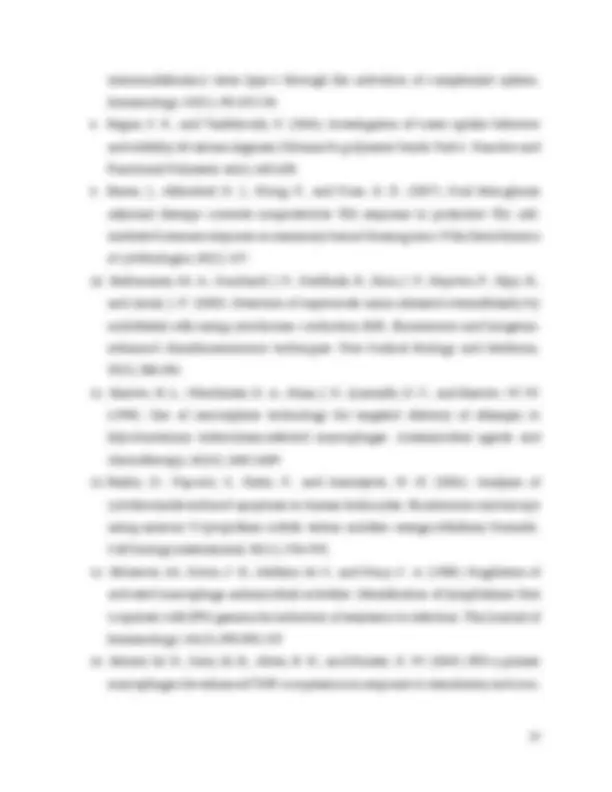
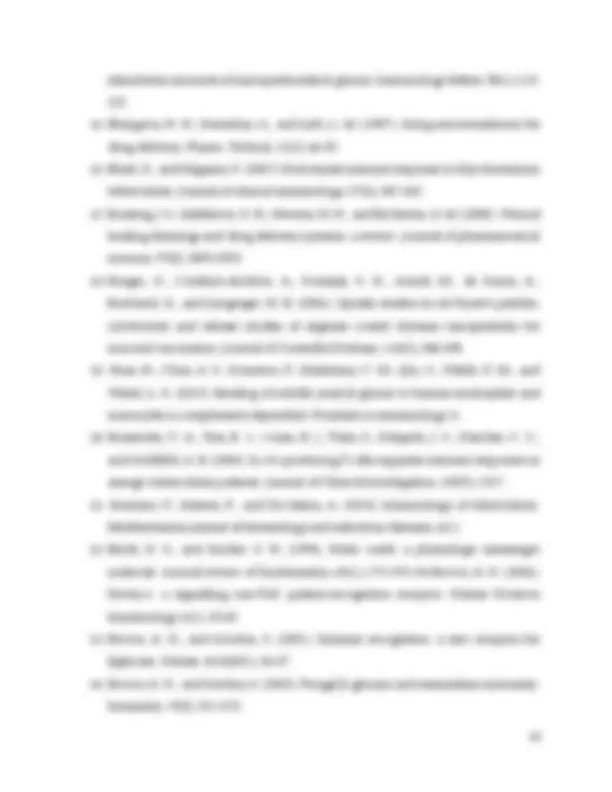
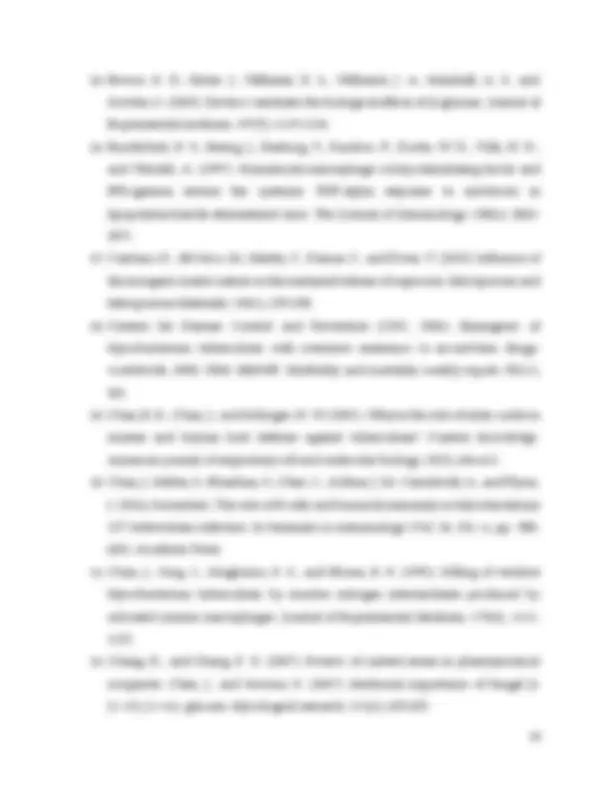
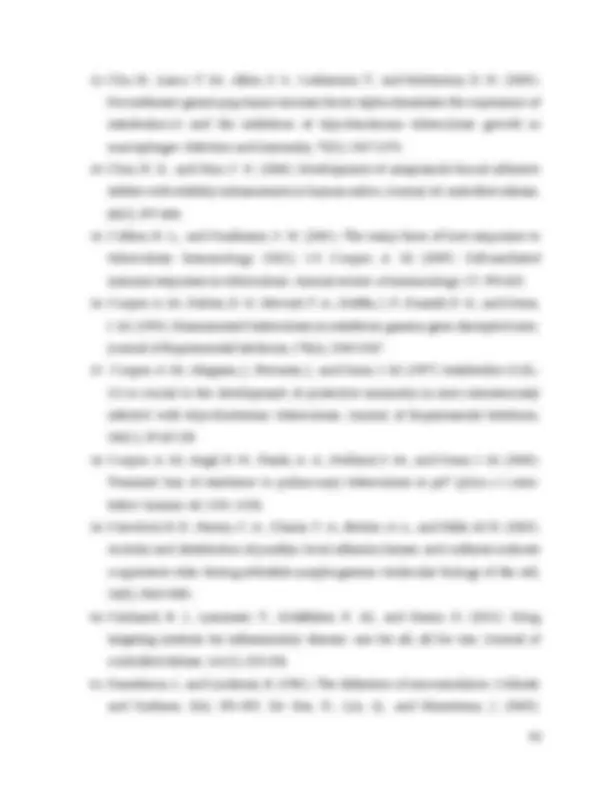
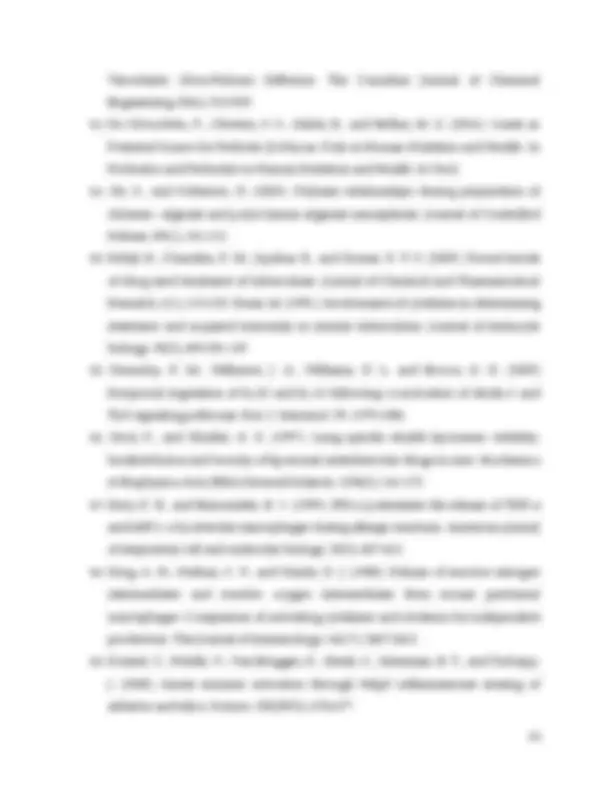
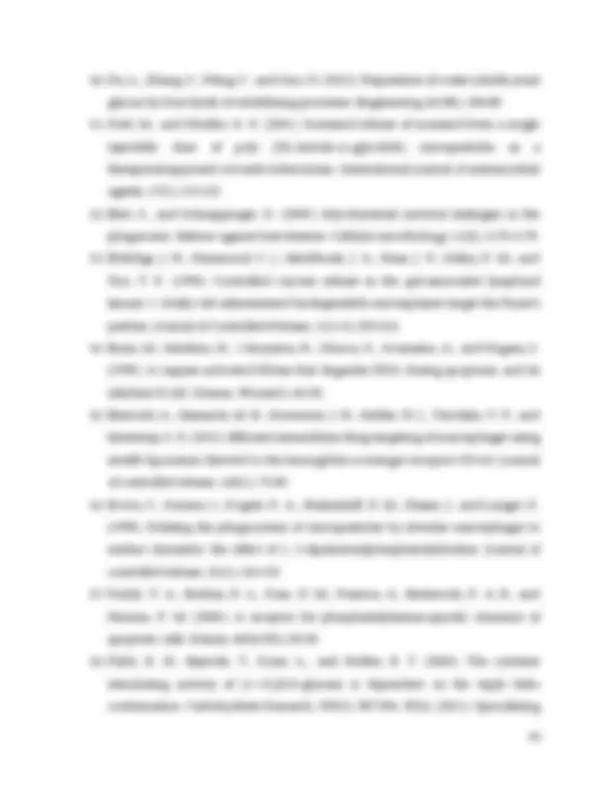
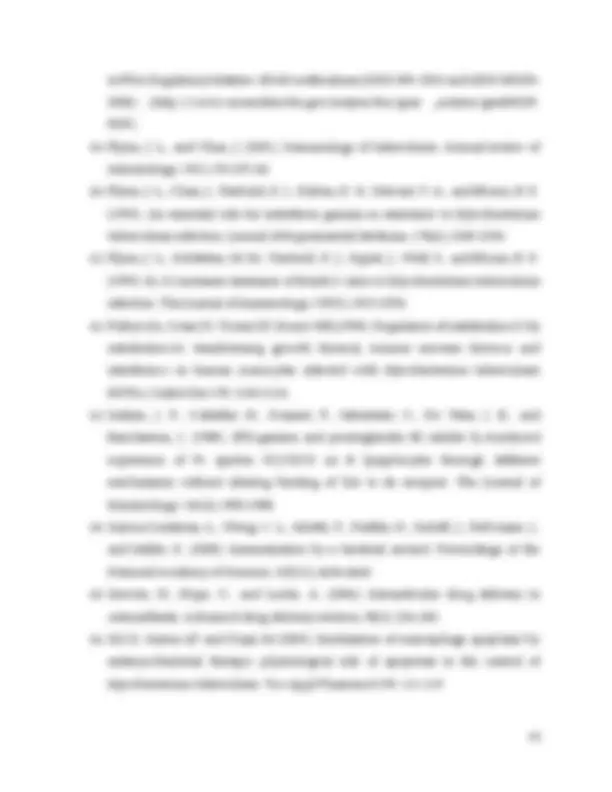
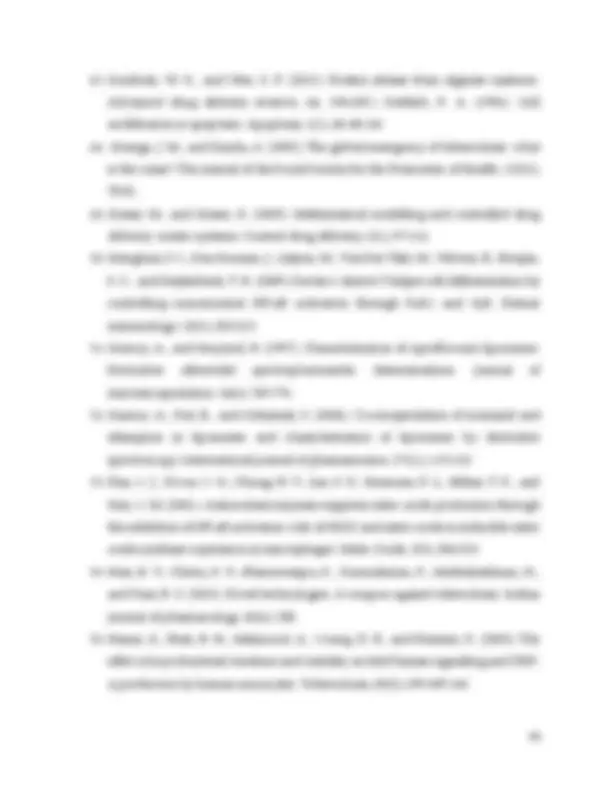
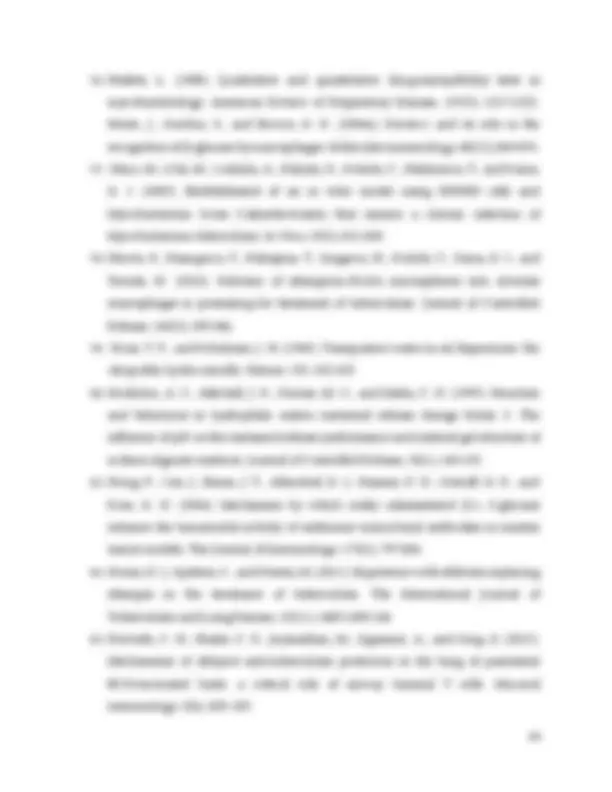
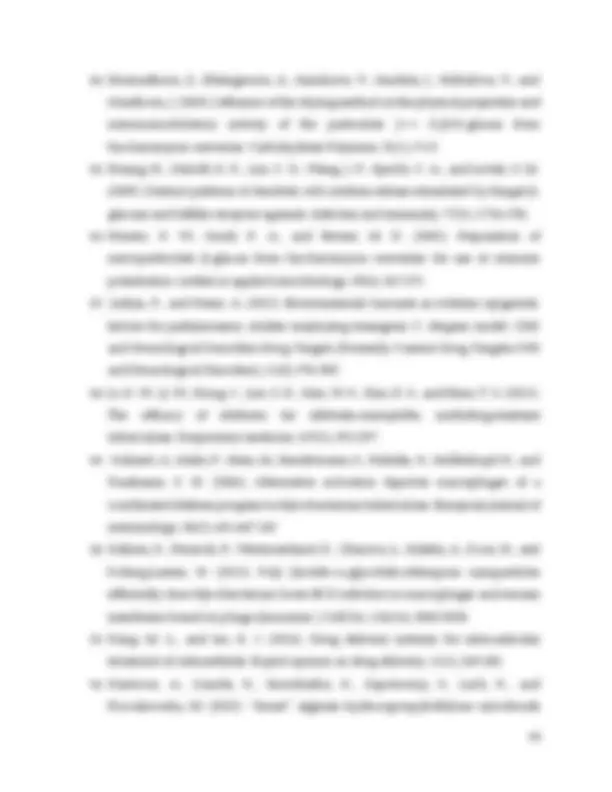
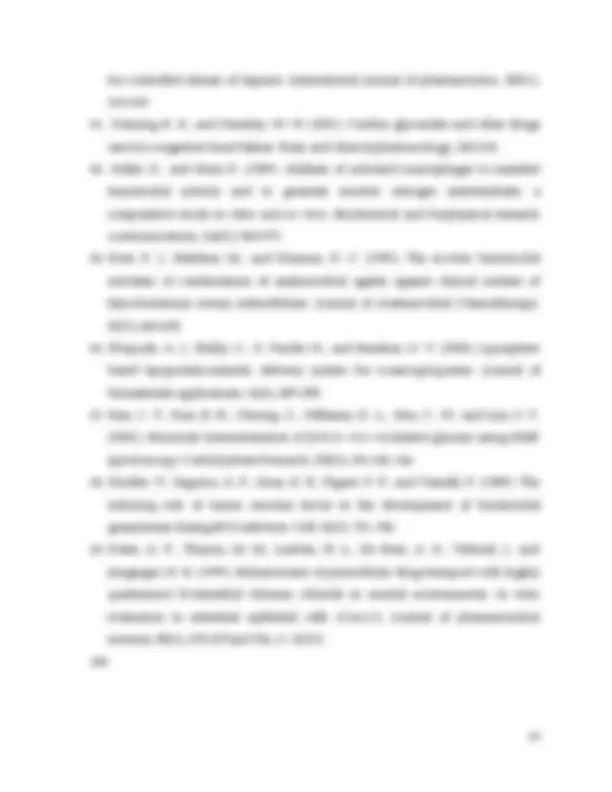


Study with the several resources on Docsity

Earn points by helping other students or get them with a premium plan


Prepare for your exams
Study with the several resources on Docsity

Earn points to download
Earn points by helping other students or get them with a premium plan
Community
Ask the community for help and clear up your study doubts
Discover the best universities in your country according to Docsity users
Free resources
Download our free guides on studying techniques, anxiety management strategies, and thesis advice from Docsity tutors
The development of new drugs and drug delivery systems to combat the global problem of tuberculosis (tb). It highlights the emergence of drug-resistant strains, such as multi-drug resistant (mdr) and extreme drug resistant (xdr) tb, which have become a major challenge in tb treatment. Various drug delivery systems, including polymer-based, lipid-based, and microparticle-based systems, that aim to improve drug efficacy, reduce dosing frequency, and alleviate toxicity. It also introduces the concept of targeted drug delivery using biodegradable polymers, liposomes, and microspheres to specifically target macrophages, the primary host cells for mycobacterium tuberculosis. The document emphasizes the potential of glucan particles and alginate particles as novel drug delivery vehicles for anti-tb drugs, with the ability to reduce antibiotic resistance and adverse effects associated with conventional tb therapy.
Typology: Thesis
1 / 47

This page cannot be seen from the preview
Don't miss anything!








































By
B.Sc. Biochemistry (6TH^ Semester) Department of Bioscience Integral University, Lucknow UNDER THE SUPERVISION OF
(Associate Professor & Head) Department of Bioscience Integral University Lucknow, (U.P) 226026 INDIA
I , Palak Singh Student of B.Sc. Life Sciences, Department of Bioscience Integral University Lucknow (U.P), Batch 2018-2021, Roll No-1801158025, hereby declare that the dissertation entitled “ Treatment of TB. ” for the partial fulfillment of bachelor degree in Life Sciences under the supervision of Dr. Rolee Sharma Head of Department, Bioscience Integral University Lucknow is an piece of work, satisfactory for the award of Bachelor of Science in Life Sciences and has not been submitted to any other university/Research institute for any degree/diploma. Date- Signature-
This is to certify the study conducted by Palak Singh during the month 5th February to 5th May reported in the present thesis was under my guidance and supervision. the results reported by him are genuine and script of the thesis has been written by the candidate himself. The thesis entitled “Treatment of TB ” is therefore being forwarded for the acceptance in partial fulfilment of the requirements for the Award of the Degree Bachelor of Science in Life Sciences, Department of Bioscience Integral University, Lucknow, U.P, India 226026. Dr. Rolee Sharma (Associate Professor & Head) Department of Biosciences Integral University Lucknow, (U.P) 226026 INDIA INTEGRAL UNIVERSITY Established Under U.P. Act No 09 of 2004 by State Ligation Approved by University Grants Commission Phone No.: +91 (0552) 2890812, 2890730, 3296117, 6451039 Kursi Road, Lucknow-226026, Uttar Pradesh (INDIA)
It is an honor for me to express my deep gratitude for those people involved in this endeavor. I take this privilege to express my deep sense of gratitude and heartfelt gratefulness to my Supervisor Dr. Rolee Sharma Head of Department, Bioscience Integral University Lucknow to allow me to work in such an esteemed laboratory and providing me an environment to complete my project. And her attention to detail untiring help and the kindness which he always bestowed on me has paved way for the successful completion of this endeavor I take privilege to express my indebtedness and deep sense of gratitude to Dr. Mohammed Haris Siddiqui, Associate Professor and Head, Department of Bioengineering, Integral University, Lucknow for his valuable suggestions and guidance throughout the study. I am also thankful to Dr. Amit Misra Senior Principal Scientist, Pharmaceutics Division, CSIR- CDRI, Lucknow, for his valuable suggestions, ever- willing help, encouragement, cooperation and moral support during the study. I wish to extend my hearty thanks to all my wonderful teachers, Dr. Swati Sharma, Assistance Professor, Integral University, Lucknow for her encouragement, cooperation and innovative ideas and moral support. I am thankful to Firoz Ahmad sir, Kratika Singh mam, for their constant help, inspiration and encouragement during my project work. I would be failing my duties if I do not thanks to my friends Abhinav Pratap Singh, Shad Ahmad, Sejal Srivastava, Naureen Siddiqui, Darakhshan Waseeque, who’s stimulating, helping hands, healthy criticism, valuable suggestions and sympathetic care throughout my work. Date- Signature-
S.N. TB Tuberculosis.
1. MDR-TB Multidrug Resistance Tuberculosis. 2. XDR-TB Extra drug resistance 3. β- GP β-Glucan Particles. 4. DB Degree of Branching. 5. MP Microparticles. 6. NEM Nano embedded Microparticles. 7. YDGP Yeast derived β-glucan particle. 8. PRR Pathogen Recognition receptor. 9. PAMPs Pathogen Associated Molecular Pattern. 10. AAE Alkaline acidic extraction method. 11. RB Rifabutin. 12. GP-RB Rifabutin loaded glucan particle. 13. Alg Rifabutin loaded alginate sealed Particles. 14. GP-RB-Alg glucan particle Alginate. 15. TDD Targeted Drug Delivery. 16. DOTS course. Directly observed treatment short. 17. CR- 3 Complement receptor-3. 18. FC- γ FC- γ Receptor. 19. SCR Scavenger receptor. 20. SEM Scanning electron microscopy. 21. GRAS Generally regarded as safe. 22. TLR Toll-like receptors 23. INH Isoniazid 24. TDW Triple Distilled Water 25. ROS Reactive Oxygen Species
S.N. Tables Page No 1 Table: 1.a. List of first line of Anti Tuberculosis drug. 12 2 Table: 1.b. List of Second line of Anti Tuberculosis drug. 13 - 14 3 Table: 1.c. List of Third line of Anti Tuberculosis drug. 15
Glucan particles (GPs) are 2–4 μm spherical, porous shells extracted from saccharomyces ccerevisiae (baker’s yeast). The hollow cavity of the particles allows for adsorption and encapsulation of payload molecules. GP also act as pathogen associated molecular pattern (PAMPS) and the surface 1, 3 β-glucan compositions of these particles facilitate receptor-mediated phagocytic cell uptake by immune cells bearing glucan receptors (e.g., Dectin-1 and complement receptor 3, CR-3, Fc-γ), such as macrophages and dendritic cells. the use of GP for delivery of macromolecules, such as DNA, siRNA and protein has been successfully demonstrated both in vitro and in vivo. the trapping of small neutral drug molecules within glucan particles is achieved by physical entrapment of the drug within GP by embedding the payload in a hydrogel that partially seals the particle pores to slow drug release. Hydrogels are high-water content materials prepared from cross linked polymers that have applications in drug delivery due to their ability to encapsulate and slowly release the target drug. These particles are thus non-toxic, biocompatible, and biodegradable polymeric and have been granted generally regarded as safe (GRAS) status by USFDA. These properties make GP an ideal drug delivery vehicle to target phagocytic, Macrophage cells in the immune system and provide the wide variety of therapeutic application in various infectious disease.
M.tb. is Non motile, obligate, and intracellular Bacteria, cause tuberculosis by inhalation of aerosolized droplets expelled from individuals with active pulmonary TB by coughing or sneezing of bacilli. M.tb. Mainly infects the Alveolar Macrophage; grow & replicate inside by Inhibition of the phagosomal maturation pathway through ESX-1 secretion system that cause the disruption of the phagosomal membrane and prevent the lysosome fusion subsequently it transforms the highly hostile conditions of the phagosome into a milder environment where it can survive and is able to replicate inside the macrophage. It is very challenging task for the elimination of the bacteria from the host cell due to This state (called dormancy state) is characterized by low metabolic rate and changing in the composition of the cell wall consequently, mycobacteria show phenotypic drug tolerance to anti-tuberculosis targeting functions required for growth. Mycobacteria have found the various strategies to maintain viability with limited or no replication. To counteract the global problems of TB, there is an urgent need to identify novel drugs to combat it. Therefore, ongoing research is focused on the search for new anti-tuberculosis drugs and natural products are an important source of them. Yet there is no effective vaccine developed against adult pulmonary TB. So that’s why the Development of new drugs in the field of TB continues to be more challenging because of the emergence of drug resistance bacteria Multi Drug Resistance (MDR), Extreme drug resistance (XDR) they will show resistant for the first line of the TB drug including isoniazid, rifampicin, pyrazinamide, ethambutol and streptomycin. Hence, research on anti-tuberculosis drug discovery to find new therapy than the existing one, to develop novel immunotherapy and potentially anti TB drug that would significantly reduce the bacterial burden, treatment time for the treatment of the MDR and XDR-TB becomes more challenging due ineffectiveness of the existing TB drug.
various aspects of macrophage- mycobacterium interactions, such as the binding of MTB to macrophages via surface receptors, phagosome- lysosome fusion, and mycobacterial growth, inhibition/damage through free-radicals’ mechanisms (reactive oxygen and nitrogen intermediates). Intracellular pathogen, which has developed numerous strategies to avoid being killed by macrophages. it is considered as the most successful pathogen capable of persisting in host for decades without causing disease. Tuberculosis is one of the main causes of mortality and morbidity globally. Tuberculosis causes more deaths each year than any other infectious disease and is second after AIDS among infectious disease. Mycobacterium primarily attacks the lungs, but it can attack any part of the body, like the kidney, lymph. 2.1. Different forms of TB. There are two forms of TB, 2.2. 2. Active TB 2.3 Latent TB, In the active TB, bacteria multiply and spread in the body thereby causing damage to the tissue. In latent TB, bacteria remain dormant in body. This phase can last for much longer time It is usually treated by taking one medicine for 9 months. 2.3. Multidrug – Resistance Tuberculosis (MDR-TB): This is onerous form of tuberculosis (TB) defined by resistance to at least two of the standard four drug anti-TB medicines (first- line antituberculosis drugs). Inadequate or inconsistent treatment has allowed MDR-TB to emerge and spread quickly. Today the treatment for drug-resistant TB takes almost two years and in addition the treatment is so complex, expensive, and toxic that MDR-TB patients struggle to live. Treatment of MDR-TB consists of second – line drugs. Many second- line drugs are lethal and have harsh side effects. Treatment for MDR – TB is administered for two years or more than that and involves daily injections. This entire health care department. World Health Organization aims to treat 80% of the MDR-TB cases by 2015. Without unique, simple,
and inexpensive treatments for MDR-TB, this is next to impossible. WHO predicted that more that 2 million people would have developed MDR – TB between (2011 and 2015). 2.4. Extensively Drug – Resistant TB (XDR-TB): XDR – TB poses a major risk to public health. This is more brutal form of XDR-TB and characterized by resistance to any fluoroquinolone and at least one of three injectable second- line drugs. This makes this XDR – TB treatment extremely problematic. in the year 2006, XDR-TB out brake in KwaZulu Natal, South Africa; 52 out of 53 people who contracted the disease died within few months. 70% of XDR-TB patients were estimated to die within a month of diagnosis. Estimation by WHO suggested that roughly 5% of (MDR-TB are XDR-TB). 3.1. Drug Regimens: 3.2. First – Line of Anti TB Drugs: In general, tuberculosis is treated with first – line drugs as a combination therapy with isoniazid, rifampin, pyrazinamide, and ethambutol for several months, these drugs are administered orally and have outstanding effectiveness against M.tb. S.N Name of drug Mechanism of Action 1 Isoniazid Inhibition of cell wall mycolic acid synthesis. 2 Rifampicin Inhibition of RNA synthesis. 3 Pyrazinamide Reduction of membrane energy; inhibition of trans-translation; inhibition of pantothenate and coenzyme A synthesis. 4 Ethambutol Inhibition of cell wall arabinogalactan biosynthesis. 5 Streptomycin Inhibition of protein synthesis. 6 Capreomycin Inhibition of protein synthesis. Table: 1.a. List of first line of Anti Tuberculosis drug. 3.2. Second line of Anti TB Drugs: When M.tb strain is resistant to isoniazid and rifampin, two of the most powerful first- line drugs, it develops into more complex form
In the second stage, mycobacterium multiplies in the macrophage, eventually causes its lysis this results in the cellular damage which attracts the inflammatory cells and blood monocytes to the area. Monocytes differentiates into macrophage and attempt to attack the microbe which is ingested by macrophage and grow inside the phagocyte. These macrophages again lyse and die due to bacterial load. Two to three weeks after infection, the third stage begins. T cell immunity develops, and lymphocytes drift to the region of infection. Presentation of mycobacterial antigens to the T cell causes their stimulation, resulting in the release of lambda – interferon and other cytokines. The lambda- interferon activates macrophages to secrete IL-12, TNF-α, IL-8, and other proinflammatory cytokines. Fast growth of M.tb. stops, at this stage, the host cell develops cell- mediated immunity. Those that are outside of the cell are resistant to antibody activated complement attack due to high lipid content of mycobacterium cell wall. Cell-mediated immunity is also responsible for much of the pathology of tuberculosis. Tissue damage can also take place when activated macrophage release lytic enzymes, reactive intermediates, and various cytokines. It is at this stage that the immune system, specifically the macrophages, will enclose the microorganisms inside tubercles. In between these structures, the atmosphere is anoxic and acidic and prevents growth of mycobacteria. This balance between host and mycobacteria called latency which is one of the hallmarks of TB. In the fifth, and final stages, the tubercles may dissolve by many factors such as malnutrition, immunosuppression, steroid use or HIV infection. For unknown reasons, the centers of tubercles liquefy an outstanding growth medium for the microbe which now begins to grow rapidly in the extracellular fluid. The large number of bacteria and the immune response against them eventually cause the lung tissue near the tubercles to become necrotic and form a cavity. Most tuberculosis infections stop at stage three. 3.3 Third line of Anti TB drugs: To overcome the problem of first- and second-line drugs, WHO has included the third- line drugs for treating TB include (RB), Thioridazine, Arginine, Vitamin D and macrolides
such as clarithromycin and thioacetazone (Grange and Zumla, 2002). Like other available drugs for the treatment of TB, third line drugs are as effective or their efficacy has not been proven (Lallo and Ambaram, 2010) 3.4. Third line Anti-TB drugs: Table: 1.c. List of Third line of Anti Tuberculosis drug. 4.1. Various drug delivery systems: at this time Nanotechnology has offer the promising attraction in drug delivery system in the form of Polymer based, lipid-based system to deliver the desired drug in targeted manner. These delivery technology Delivery agents play crucial roles in the synthetic transportation of materials into cells. An effective delivery agent is defined by three key characteristics. First, the delivery agent must protect the material being transported and preserve the material from degradation. Second, the material needs to be successfully delivered into the target cells through the cell membrane. The last characteristic is that the delivery agent should have minimal detrimental effects on the target cell. 4.2. Micro emulsion: The concept of micro emulsion was first introduced by Hoar and Schulman in 1943(Hoar and Schulman, 1943). Micro-emulsion is a system of water, oil and an amphiphilic (surfactant and co-surfactant) which is a single optically isotropic and S.N. Drug name Mechanism of action
4.3. Micro and nano-particles: Inhaled microparticles containing Anti–TB are rapidly phagocytosed by alveolar macrophage and are targeted thereby to macrophage cytosol, which is the primarily site where the mycobacteria reside and actively multiply (Sharma et, al., 2007, Yadav et, al., 2009 Sharma et, al., 2011). This suggest that administration of microparticles containing anti – TB drugs may be useful for treating TB, by targeting macrophage – resident persistent mycobacteria, improving drug efficacy and thereby offering promises of dose and dosing- frequency reduction as well as toxicity alleviation. Figure: 2.a Various type of Drug Delivery system.
4.4. Targeted drug delivery against TB: Biodegradable polymers, liposomes, and microspheres have been developed in order to reduce the dosing frequency and days of the treatment (Hari et. al., 2010). Attempts have also been made to enhance the delivery of loaded drug to specific lung tissue as an overall requirement of formulations meant for targeting lung macrophage in an efficient manner. Targeted drug delivery allows controlled release of drugs and cause minimum toxicity as compared to the conventional oral dosage. Therefore, while free antibiotics need to be administered daily, new formulations such as nano- or microparticles have been seen to effective even when administered after a few days. Injectable INH loaded PLGA microparticles have been prepared by Dutt and Khullar (2001) and successfully evaluated for treatment of TB in M.tb. H37Ra infected mice model. Similarly, RIF loaded biodegradable microparticles have been evaluated for anti-TB activity following H37Rv infection in mice model for targeted delivery to host macrophage. These were also shown to significantly decrease the number of viable mycobacteria at 7 days following initial infection within H37Rv infected murine macrophage cells J774 and human Mono Mac 6 cell lines (Barrow et. al., 1998) and in M.bovis BCG infected rat alveolar macrophage NR8383 (Hirota et. al., 2010). A study on the comparison of the anti-TB efficacy of RIF loaded microparticles (RIF-PLGA) with pure drug administered to respiratory tract of M.tb. H37Rv infected guinea pigs, exhibited that the guinea pigs treated with RIF-PLGA had a significantly smaller number of viable bacteria, reduced inflammation and lung damage than lactose or saline control, PLGA or RIF treated animals (Suarez et. al. , 2001b). RIF–PLGA microspheres have been reported to be safe due to their “silent” nature when taken into rat macrophage cells and that they are promising for the treatment of tuberculosis (Hirota et. al., 2010). INH or RIF stealth liposomes with enhanced affinity towards lung tissue were prepared by modifying the surface of stealth liposomes by tagging O - stearyl amylopectin so as to enhance the drug targeting to lungs, and were seen to have increased affinity towards the lung tissue of mice (Deol and Khuller, 1997). Multiple emulsions of RIF also gave a controlled release profile, and coating of these